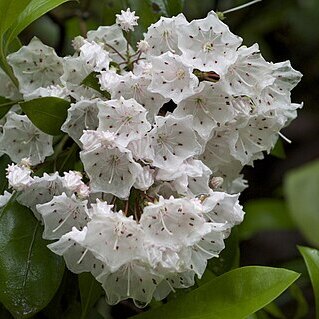Shrubs (rarely trees in K. latifolia). Stems erect, (branched and mat-forming in K. procumbens); twigs glabrous, puberulent, or stipitate-glandular, sometimes glabrescent. Leaves persistent (deciduous in K. cuneata), alternate, opposite, or in whorls of 3; petiole present; blade usually coriaceous, (base cuneate or obtuse), margins entire, (midvein abaxially glabrescent, puberulent, or glandular; buds flattened with 2 exposed, valvate to overlapping scales). Inflorescences axillary or terminal, racemes, umbels, panicles, or fascicles, 2-40-flowered, sometimes flowers solitary; perulae present. Flowers bisexual, radially symmetric; (calyx synsepalous, lobes deeply cleft), sepals (persistent, deciduous in K. hirsuta), (4-)5, (green or greenish), connate; petals 5, connate for nearly their entire lengths or distinct, corolla deciduous, sympetalous and saucer-shaped to polypetalous and campanulate, (tube extending into rotate, shallowly 5-cleft (deeply cleft in K. buxifolia, K. procumbens), commonly 10-keeled limb, limb with 10 saccate pockets in which anthers are held under tension, absent in K. buxifolia, K. procumbens); stamens 10 (5 in K. procumbens), included; (filaments usually hairy near base); anthers (usually purple), without awns, (ovoid), dehiscent by apical (or longitudinal) slits; ovary (2-)5-locular, (glabrous, stipitate-glandular in K. buxifolia); styles included, (straight or bent); stigma (5-lobed), capitate. Fruits capsular, (5-valved), subglobose to globose, dehiscence basipetally septicidal. Seeds ca. 100-150, obovoid, oblong, or ovoid, often winged, tailed; testa reticulate. x = 12.
More
Fls 5-merous; cal deeply lobed; cor subrotate, shallowly lobed, 10-saccate about halfway from base to margin; stamens 10, the short anthers at first fitting into the cor-sacs, the filaments later springing inward; anthers opening by 2 large apical slits; ovary 5-locular; style elongate; stigma truncate; capsule ovoid to depressed-globose, indented at the top, septicidal; evergreen shrubs with conspicuous fls. 6, N. Amer.

